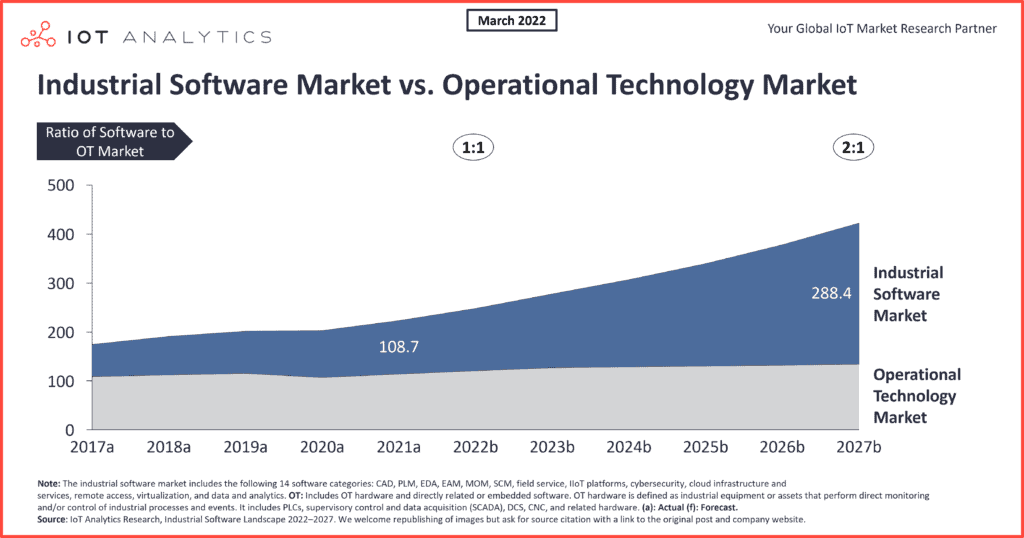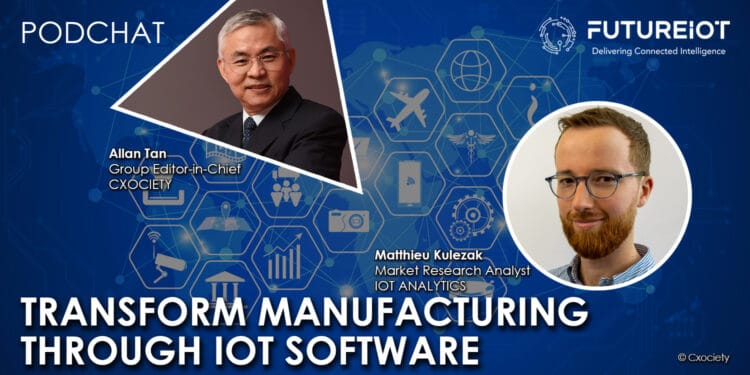While manufacturing has traditionally depended on software technologies like manufacturing execution systems and enterprise resource planning to keep materials inventory in lockstep with customer orders, innovations around the Internet of Things, analytics and machine learning, and cloud and ubiquitous connectivity are maturing to the stage where we may be seeing the emergence of the long-heralded smart manufacturing revolution.
IoT Analytics market research analyst, Matthieu Kulezak, acknowledged a persistent confusion in the market as regards what constitutes IoT software. He points to vendors that refer to IoT software as a bigger umbrella term for any kind of software that they wish to fit and bundled together.
For its part, IoT Analytics classifies it as a subset of a more extensive umbrella called industry software. In a typical manufacturing firm, for example, there’s designing, manufacturing, supply chain and service involved.

There are very specific functions, operations, and software for each of these steps which make up the three types of IoT platforms: application enablement, device management and data management.
At FutureIoT, we dare ask: are we at the beginning of software-defined manufacturing? And if so, how do we transition to this future?
IoT software is evolving
Back in 2017, the industrial software market was approximately 40% smaller than the hardware-centric OT market, but things are changing quickly.
Kulezak noted that back in 2018, the researcher estimated about 600 vendors selling software specific to IoT platforms. Fast forward to 2022, he estimates that about 200 of those vendors have stopped developing IoT platforms. He posits that the industry may be seeing consolidation as major players vie for a larger share of the market and a stable value proposition.
He posits that 2022 is a turning point for manufacturers.
For the first time, the average manufacturer will spend more on industrial software than on industrial automation hardware (OT hardware), according to IoT Analytics’ latest report on the industry titled Industrial Software Landscape 2022–2027.
Kulezak acknowledged that the pandemic and the boost in digital transformation efforts have benefited the software industry.
Ten years after Marc Andreessen, in 2011, proclaimed that “software is eating the world,” manufacturing is becoming software based. It is estimated that five years from now, the industrial software market will be twice as big as the OT hardware market. (The total market size for 2021 is $109 billion; the estimate for 2027 is $288 billion).
Why manufacturers are embracing cloud
Kulezak commented that manufacturers are embracing the software-as-a-service movement and cloud. But in the process, they are also discovering the limitations of the SaaS model – customisation. As a compromise, he noted a rise in interest in low-code and no-code platforms.
He opined that customisation was part of the legacy on-premises strategy of the past. With the cloud and SaaS model, the underlying intent is to harness the other benefits of cloud – scale and flexibility.

He further posited that customisation introduced complexity.
“That would be way too complicated to scale up. I think here the key is to go with a flexible go-to-market approach so flexible deployments and something quite standard so you can scale up."
Matthieu Kulezak
Recommendations
He suggests that manufacturers start very simple.
“Do trials and explore the new capabilities. It does not have to be a very complicated customised software which would be difficult to scale up in the future. Go for low code no code platforms, start with a standard, and then scale up,” he added.
“Digitisation requires leadership and commitment so IT leaders are doing more than before. There are security concerns which is why higher-level commitment is essential so the digitisation journey is smooth.”
Matthieu Kulezak
Click on the PodChat player to hear in detail Kulezak’s observations on how IoT is helping the digital transformation of manufacturing and hear his recommendations on how to take advantage of the opportunities.
- Define IoT software.
- Looking back from pre-pandemic to this period (mid-August 2022), how have things changed when it comes to IoT software?
- In the period of accelerating digital transformation, which areas of IoT software have gained in importance?
- Which software trends are helping in terms of IoT software adoption and development?
- What needs to happen for organisations in manufacturing for us to see greater integration of IoT software in industrial settings?



